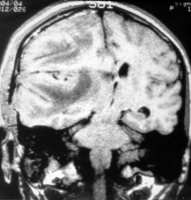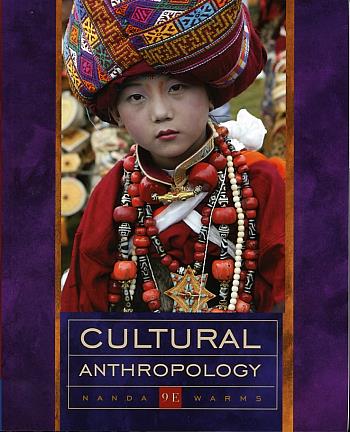November 3, 2006
Families
Every culture has families, but finding an adequate definition of
"family"
is surprisingly difficult.
Virtually every function the family performs in a culture is
also done
by other institutions within the culture.
What are these relationships' true meaning? Families are
behavioral
entities that relate more to property and influence than you might
think,
and they are more complex and variable than you might imagine.
Nuclear Families
When you think nuclear family, think of the classic image of mom, dad,
2.5 kids 1/2 a dog, 1.5 cars and a house in Levittown.

An Early Family Poses in Front of their 1948 Cape Cod
(You can find more information about Levittowns
at: http://www.lihistory.com/specsec/levmain.htm
and http://tigger.uic.edu/~pbhales/Levittown.html)
The problem is: Does the Nuclear Family Really Exist?
Our concept of the nuclear family is a post-war (WWII) concept. While
the American middle class might have lived in nuclear families in the
1950s
and 1960s, many do not today, and historically, some form of extended
family
might have been more the rule than the exception.
In 1900, for example, the middle class was defined as a family
with
6 or fewer servants! This was the top 1 or 2 percent, and included a
large
"extended" family.
In late 19th and early 20th centuries a new wave of immigrants
came
to America. Immigrants were "clogging" up American cities, scaring
everyone.--
the solution: sweep through cities and collect up children, who were,
in
the opinion of citizens, uncared for!
THE Orphan Trains
The following is quoted from http://www.orphantrainriders.com/otm11.html:
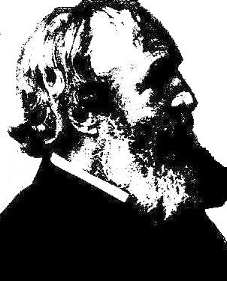 In 1853, Charles Lorring Brace and a group of businessmen formed a new
organization to help care for neglected children. They called it the
Children's
Aid Society of New York City with Mr. Brace as the first Secretary.
In 1853, Charles Lorring Brace and a group of businessmen formed a new
organization to help care for neglected children. They called it the
Children's
Aid Society of New York City with Mr. Brace as the first Secretary.
In a book, Dangerous Classes and My Twenty Years of Work
Among Them,
Mr. Brace described the conditions children were living in and the
organization
formed to care for them. This care led to the "free-home-placing-out"
of
over 150,000 children between 1854 and the early 1930s.
How the program worked
Children were taken in small groups of 10 to 40, under the supervision
of at least one "western" agent, traveled on trains to selected stops
along
the way, where they were taken by families in that area. It was an
early
form of foster care.
By 1860, 30,500 miles of tracks had been laid. Eleven
railroads met
in Chicago. A person could leave Boston by railroad and reach St. Louis
in three days. By 1870 the trains ran from the East coast to Omaha,
Nebraska.
The history of the railroads is deeply tied to the history of
the "Orphan
Trains Era" in America. Railroads were the most inexpensive way to move
children westward from poverty filled homes, orphanages, poor houses,
and
off the streets. In the west, and mid-west, Brace believed, solid,
God-fearing
homes could be found for the children. Food would be plentiful with
pure
air to breathe and a good work ethnic developed by living on a farm
would
help them to grow into mature responsible adults able to care for
themselves.
The first group of children went to Dowagiac, Michigan, in
1854.
Annual reports of the Children's Aid Society prints selected
letters
from the children. Glowing reports of a good life with a caring family
often closes with a wistful, "If you should see my brother, please tell
him where I am."
What Do We Make of This? Was it shameful?
It was done in the name of philanthropy and foster programs are still
controversial.
Whatever we say, it doesn't much match out idea of nuclear
family.
Where do the orphan train kids fit into the American notion of
the nuclear
family?
Extended Families
Most people in the world live in some sort of extended family.
An extended family is any family that includes more than two
generations
or includes the nuclear families of siblings.
Traditional Ethnographic Extended Family,
Traditionally, extended families include all the individuals directly
descended from a single individual. For example, your
grandfather's
three sons, their wives, children, grandchildren and so on. Generally,
extended family is either patrilineal or matrilineal (more about these
later).
In modern industrialized nations, families come in everyh form
you can
think of, including very extended families from divorces, etc. There is
no socially accepted way of dealing with this kind of complexity, and
there
is no terminology for them!
Marriage, like family is also tough to define.
Marriage Types
Monogamy: a single man and a single woman; accounts for a
relative
minority of the world's societies.
Polygamy: one individual married to more than one
individual
Polygamy is divided into Polygyny and Polyandry.
Polygyny and Polyandry
Polygyny is the practice of one man marrying several
women.
Polyandry is the practice of one woman marrying several
men.
Polygyny is extremely common-- most of the world's
societies
permit polygyny-- it becomes a position of status... more wives you
have,
more status you gain-- most people within those societies still have
but
one wife.
Polyandry is extremely rare, well under one percent of
societies
allow it (and in those that do, it is usually fraternal).
November 6, 2006
In 100% of the world's societies there is an equal number of
men to
women-- the supply of women is the same.... the supply of men is the
same...
so how do polygamous societies function?
Polyandry
Polyandry is common where it is permitted, but it is not a status
position.
Fraternal polyandry is most common form --- 3 or 4 brothers marry a
woman mostly to keep b rother's property together... assures
inheritance
will stay amongst them.
Polyandry mostly occurs where there is not a lot of land available
and providing for children is difficult. It tends to exist where social
or land conditions are very harsh, places like Tibet. If there are
"extra"
women, they tend to become celibates.
Under 1% of all societies permit polyandry.
Polygyny
Polygyny is Widely Allowed
But Not So Widely Practiced
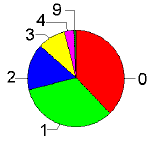
This chart shows the number of wives per husband among the
Dani,
a polygynous society Note that the vast majority of men
are either unmarried or have only one wife!
(from Warms' lecture notes)
Where do the extra women come from?
Even with relatively few people married polygynously, there is still
a shortage of women.
This is generally solved by increasing the number of "marriage years"
for women and decreasing it for men. Thus, men marry
relatively
late in their lives but women marry relatively early.
Example:
Imagine everyone dies at 60 years old.
If men marry at 30 that equals 30 years of marriage
If women marry at 15 that equals 45 years of marriage
Therefore, women have more years of marriage and unmarried men at near
30 remain unmarried, but there are no unmarried women past 15-18 years
old.
It's not unusual in polygynous societies for a teen woman to
marry a
60 or 70 year old man, usually wealthy, and usually an arranged
marriage.
(Until 20th century most marriages were arranged!)
Re-marriages are common!
Wives in a polgynous marriage are called co-wives.
Polygyny is Popular
Americans overwhelmingly reject the idea of polygyny, yet huge
numbers
of people around the world find it extremely desirable. Perhaps
the
majority of the world's population would rather be married
polygynously.
Why should this be true?
Polygynous families obviously have more kids than other types
of families.
This is a good thing in societies where having more kids means less
economic
deficit and more of an economic "good deal". This is in societies
where
it costs less to raise a child (not in the US!!)
Numbers Behind the Numbers
In today's dollars:
In 1970, to raise a middle class American child through its 18th
birthday:
$140.965
In 1999, to raise a middle class American child through its 18th
birthday:
$236,600
Add college to that: $32,000 (four years of Texas State) or $125,864
(four years of Harvard)
What are the chances that the average parent will see more
than a
quarter million dollar financial benefit from a child?
On the other hand, the less it costs to
raise a child,
the greater the chance of seeing financial benefit.
Is the Bottom Line the Bottom Line?
Polygyny means more kids in your family...and in many societies, more
kids means more wealth. So, the choice is marry polygynously and marry
wealth. Marry monogamously and marry poverty.
Declining US Marriage Rates
| |
1970 |
1998 |
Change |
Women Aged 40-44
who have not married |
5.4% |
9.9% |
+83.3% |
Men Aged 40-44
who have not married |
7.5% |
15.6% |
+108% |
| Single-Parent Families |
3,271,000 |
9,491,000 |
+190% |
| Non-Marital Births |
399,000 |
1,249,000 |
+223% |
The statistics show a clear disconnect between
children,
families and marriage.
Since children's economic value is negative,
their primary
value is emotional.
Thus
:a) People decide that they don't need that and
are better
off without kids (consider dinks and gay couples).
b) People decide that they want kids but are just as well off without
marriages (Men, in particular, may be highly motivated to leave
marriages).
...and population replacement oocurs in interesting patterns:
Kid Stats
Total Fertility Rates: Nations and States
Lifetime Births Projected per 100 Women
Currently
of Childbearing Age (Needed for
Replacement: 211)
|
|
High Rates
|
Low Rates
|
| Yemen |
760 |
Canada |
155 |
| Uganda |
730 |
Japan |
143 |
| Afghanistan |
690 |
Austria |
141 |
| Angola |
680 |
Russia |
134 |
| Chad |
607 |
Hong Kong |
132 |
| Iraq |
525 |
Germany |
130 |
| Bolivia |
436 |
Italy |
117 |
| India |
313 |
Spain |
107 |
| |
|
Within the United States
|
| 1960 |
365 |
White |
185 |
| 1970 |
248 |
Asian |
193 |
| 1980 |
184 |
Black |
215 |
| 1999 |
208 |
Hispanic |
298 |
| |
| High
Rates |
Low
Rates |
|
Utah |
271 |
Pennsylvania |
180 |
|
Nevada |
251 |
Massachusetts |
174 |
|
Arizona |
244 |
West
Virginia |
166 |
|
Alaska |
241 |
Maine |
161 |
|
Texas |
238 |
Vermont |
157 |
Sources: [New York Review of Books, 47(19)] The
United Nations
and National Center for Health Statistics. US ethnic rates are
for
1999; state rates are for 1998; and other country rates are from
1995-1999.
The replacement figure will be greater than 211 in countries with
higher
infant mortality rates.
(charts fromWarms' lecture)
  November 8, 2006
November 8, 2006
TO SUMMARIZE:
Culture is Kid Neutral because the population of
women
remains constant.
Individuals are Kid Positive because, in most
societies,
they mean wealth.
In wealthy nations, kids are expensive, a poor investment of
money and
the population of the middle class is declining.
Having kids in poorer countries is cheap and a better investment as
you children will work and thus the family will recoup their
investment,
and therefore polygyny is a good investment.
More about polygyny:
In traditional societies, kinship is politics, therefore the
most power
goes to the largest families.
Why would a woman prefer polygyny?
In underdeveloped countries most of the domestic labor is done
by women--
a wman's workload is lightened by polygyny--- there's more kids
for labor.
In theory, 1st wife is boss of 2nd wife, who is boss
of 3rd wife,
etc. This ability to rule the roost is a powerful motivation for
polygyny...
an exception is when the "4th wife" is very young, but there's a "rule
of equal sharing" in every polygynous culture.
(By the way--- we must remember that some form of divorce
is present
in all societies. In most cultures, men control divorce proceedings,
but
women always have ways to equalize the process.)
Protection -- Polygynous relationships, when in
patriachal and
patrilineal societies, offer security to a woman. When she becomes a
part
of her husband's family she is a total stranger (remember most
marriages
are arranged)-- she will get allies in the other co-wives-- protection
from possible violence from men.
Disadvantages of polygyny
Jealousy and rivalries between co-wives, especially
when a man
has more than 2 wives.
Dual morality for men and women. It's the man
who marries
polygymously-- woman are essentially monogomous. This means there is a
morality gap in polygymous societies as a man can have relations with
other
women (they could be looking for another wife), but women cannot do the
same with men. The penalties for women violating this arrangement are
sometimes
severe and a certain amount of brutality is accepted--- but not too
much...
in other words, it's okay to occasionally beat your wife... but not
too much-- doing that most always creates a serious decline in a man's
respect and prestige. Rewards must exceed punishments within the
relationship
in order for the man to gain respect.
November 13, 2006
Anomalous Marriage Types
While they are relatively rare, unusual types of marriage challenge
our notions of what marriage is and what is normal.
Three unusual forms of marriage are found among:
The Nayar (an Indian sub-caste)
Nayar men do not truly marry... a young girl is married to an older
man, then they frequently never see each other again.. there's no sex,
no living together. Marriage is not necessary in order to have
descendants--
instead, Nayar children are descendant from women having sex with other
Nayar men who are not married to her. Men have sex with other women,
non-Nayar
or in a different group within the same caste. The Nayar are
matrilineal
and children belong to the mother's family.
"In Nayar marriages, wives stay within the shelter of their
mother’s
households throughout their lives, and husbands continue to live in
their
mother’s households. A Nayar wife lives with her grand mother, her
mother,
her aunts, her uncles, her sisters, her brothers, her cousins, and
assorted
children. These close blood relatives provide a sympathetic reference
group
empowering a Nayar female at every crossroad throughout her life. A
husband
is allowed to visit his wife’s family compound and her apartment at her
convenience." quoted from http://www.jadski.com/kerala/f4femalesexuality.htm
What is the point in all this? The Nayar are a warrior
caste---
warriors who never marry-- this gives protection and support to the
matrilinear
lines and creates a system of vassalage for the men.
Some West African groups
Female Husbands in Africa
In some African groups, children belong to the family of the husband
in a marriage (Patrilineal)
If a wife wants children in her family, she can marry another woman.
In THAT marriage, she is the husband, and the woman's children belong
to her family!
This form of marriage is reported for 30 African groups but probably
most common in Benin and Nigeria.
The Indians of coastal British Columbia
Kwakiutl Man/Man Marriage
Among the Kwakiutl, and other NW Coast tribes, a man can marry
part of another man.
So for example, I could marry the chief's right kneecap.
Since I would then be the wife of the chief, my children would be the
sons and daughters of the chief. The Chief gets more kids-- lots more
kids,
and with no easy method to determine a successor. It's not considered
reasonable
for relatives to fight... socially very unacceptible.
Totem poles are a thing only found in the northwest and they
represent
a particular claim of lineage and position. Lots of people have claims
for any one position and so competitive feasting becomes necessary in
order
to win over allies, to impress them.
Of course, marriage to the Chief's kneecap requires payment of
bridewealth.
November 15, 2006
What's The Point of marriage?
Marriage is about social relations, especially in the
traditional world,
pre-1850.
The great variation in forms of marriage point to the fact
that marriage
is really less about a relationship between two people who love each
other
than it is about alliances and inheritance between two groups of
people.
Marriage is best thought of as a contract between two
groups.
Marriage is about rights to children.
The individuals involved really may not matter too much.
Some common social practice that really points this out are the levirate
and the sororate. Both of these situations are designed to keep
arrangements together, even after the death of a property-holding
spouse.
In a levirate, a widow marries ("is inherited by") the
deceased
husband's brother, or other male member of household. Any later
children
produced are the original husband's children.
In a sororate, a widower marries the deceased wife's
sister(s).
The wife's family loses out here because they cannot arrange the
marriage
of that sister.
"To death do us part" means nothing in this kind of marriage.
A failure of the marriage system between families end up in
sometimes
deadly feuding. Property is at stake here, as are inheritances and
power.
Marriage is mostly a movement of women, the other side of
which is the
movement of property.
Generally service, goods, and money change hands at a
marriage.
Payments come in four forms:
1. Sister Exchange: In sister exchange marriage, families agree
to exchange women.
Sister exchange marriages may be cross-generational;
2. Bride Service: In bride service the groom agrees to work
for the family of the bride for a specified period of time--Many times
marriage rights increase over time and each culture sets parameters for
this-- sometimes it is many years before the couple live together or
sleep
together;
3. Bridewealth: Bridewealth is a payment from the family of
the husband to the family of the wife. Bridewealth is extremely
common.
It functions to hold marriages together and to compensate the family of
the bride for the loss of her labor-- consists of cattle, cloth, grain,
money, kola nuts, etc., all negotiable items. Divorces are difficult
because
many times the bridewealth would need to be returned, or some other
negotiated
settlement;
4. Dowry: Dowry is a payment from the family of the wife to
the family of the husband.
It is common in areas where land is in short supply and families
difficult
to support.
It is particularly common in Europe and India. Females are devalued
in this system-- in theory payment is necessary for a daughter in order
to support a family. Failure to pay dowry can be devastating as women
have
been kileed by hubands when families have failed to pay dowry.
Dowry is a very controversial thing in present-day India.
Google "dowry"
and you're likely to recieve many hits from anti-dowry editorials and
movements.
Here's a link to an editorial purporting to show flaws in the
anti-dowry
legislations.. a quote from which: "Destined to fail:
The present day dowry system symbolizes the disinheritance of women
and the resulting desperation of parents to push their daughters out of
their homes after marrying them off. Madhu Purnima Kishwar points to
inherent
flaws in the anti-dowry legislation, and argues that equal inheritance
is the way forward..." India
Together July 2005
November 17, 2006
Incest Taboo
Every society splits humans into two social groups: those people one
can marry (and/or have sex with) and those people one cannot.
That
is to say, every society has an incest taboo.
However, different people are in these two groups in different
societies,
and that makes explaining the incest taboo difficult.
Brother/sister
and parent/child sex taboos are nearly universal--- in fact, in most
cultures,
50% of people one knows are forbidden.
Three explanations are generally offered but each has its
problems and
none seem entirely satisfactory:
1. Genetic/Biological explanation-- Whike the truest explanation in
which interbreeding causes horrible defects, biology alone can not
really
explain this taboo. It was a taboo in cultures completely ignorant of
genetics
and biology;
2. Sociological explanations-- As proposed by Levi Strauss, this taboo
forces you to m,arry "outside" of the family in order to create
alliances
between families. Having many alliances has its advantages therefore if
you marry those close to you, you decrease your chances of survival in
a time of stress. Trouble with this explanation is that the
explanation is about marriage and incest is about sex.
3. Instinctual explanations: Humans have a hard-wired tendency
to find people with whom they are raised sexually unappealing. However,
this kind of incest happens frequently... and if this explanation were
instinctual, there would need to be no taboo!
But none of these explanations is, on its own,
entirely satisfactory.
Kinship
Kinship is distinct from family. It is the system through which
we name those who we consider our relatives. Kinship is a system
of naming, but what is in a name?
Relational names: mother, father, cousin, etc..
Biological metaphors: "father" as title for preacher, of
God.
Names representing "rights and responsibilities": by using
certain
names for people, we are announcing the kind of behaviors and
behavioral
expectations we associate with that "title."
Put another way:
When we call someone a kin name, we are using words that are rooted
in biology, but are actually metaphors. When we say "He is my brother."
we mean the same kind of thing we mean when we say "He is a pain in the
butt."
That is: An aggravating person does not literally make your rear end
hurt. And a brother is not necessarily someone with whom you share
genetic
material.
Kin names identify behavioral roles!
There is no reason at all that all that all societies must
assign kinship
names similarly.
Outstanding kinship tutorials can be found at: http://www.umanitoba.ca/anthropology/kintitle.html
and at
http://daphne.palomar.edu/kinship/default.htm
Who's family are we a part of?
Kinship Symbols
Female
|

|
Male
|

|
Marriage
|
 |
Siblings
|
 |
Descent
|
 |
Are You A Member of Your Mother's Family, Or Your Father's
Family?
For us, the question doesn't really make much sense. We are
members
of both our mother's and our father's family. Our system is
called
Bilateral Kinship and the family groups that it creates are called
Kindred.
(Bilateral kindred, in this case.)
Bilateral Kindred System
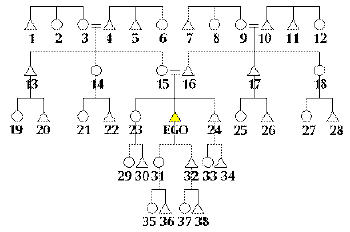
EGO is you, most times ego is represented by a
square.
(chart from Warms' lecture notes)
Bilateral kinship systems are not the most common. There are a
lot of
people in this system, but the cousins of your cousins are not your
cousins!
Only brothers and sisters have the same kinship. Your brother-in-law's
cousins are not your cousins either!
November 20, 2006
Unilineal Systems
Most cultures use Unilineal kinship systems reckoning their families
through either their mother's line or their father's line but not both.
Most unilineal kinship systems are either patrilineal or
matrilineal.
Bilateral kinship systems bind a large number of categories together
loosely, unilineal systems bind a small number of categories together
tightly.
You're either in the family or out of it.
Patrilineal Kinship
Most societies are patrilineal. In a patrilineal society, children
belong to the family of the father and property is usually passed from
fathers to sons.

(chart from Warms' lecture notes)
Matrilineal Kinship
A substantial minority of societies are matrilineal. In a matrilineal
society, children belong to the family of their mother but property and
power pass from mother's brother to sister's son.

(chart from Warms' lecture notes)
Note that matrilineal societies are not matriarchal societies!
Men definitely
run these families... but the woman's family line determines where the
property passes.
Naming Names
Since kin names refer to behavioral expectations rather than to
biological
realities, they can be assigned using any pattern or system one wishes
to use. (Behavioral expectations as set by societies).
However, these patterns are, in large, set by societies and
not individuals,
and they use a specific set of criteria.
A "kinship system" is a specific application of these
criteria.
It turns out that there are 7 criteria and 6 kinship systems.
Criteria
The criteria are different rules that are invoked in creating kinship
systems. For example, if the criterion of gender is used,
individuals
of one gender are called by one kin name and individuals of the another
gender are called by a different name. If the criterion of gender
is not used, then individuals would be called by a single name
regardless
of their gender.
The criteria are: Gender, Generation, Lineal vs.
Collateral,
Consanguine vs. Afine, Sex of Linking Relative, Bifurcation (side of
family), and
Relative Age
Lineal vs Collateral--
Lineals are what we would call mother, father, sister, brother and
your kids (but not your brother and sister's kids)-- all others are
collaterals
Consanguine vs Afine --
Consanguine relatives are blood relatives, affines are, for example,
your brother's wife (marriage relations, in-laws under our system)
Kin Systems
The six major kinship systems were identified by Louis Henry Morgan
in his 1871 work Systems of Consanguinity and Affinity of the Human
Family.
The criteria are found in Morgan's six different kinship
systems.
These systems are named after Native American groups. However,
they describe types that are found all over the world. They are: Hawaiian,
Eskimo,
Iroquois, Omaha, Crow, Sudanese. Though they might be
modified
slightly, these six systems seem to describe kinship systems
represented
in all cultures!
An explanation of several main systems-- we won't
review them
all:
(NOTE: Letters represent roles, A & B, for example,
representing,
respectively, Father and Mother; C and D representing,
respectively,
Brother and Sister, etc..)
Hawaiian Kinship

The Hawaiian System Uses Only Sex and Generation-- the
simplest
system.
(chart from Warms' lecture notes)
So, assuming bilaterality, under the Hawaiian system Ego's
(your) Mother's
and Father's brothers and sisters are all called Mother and
Father,
and all of their kids are your brothers and sisters.
Eskimo Kinship

Eskimo Kinship Uses Sex, Generation,
and the distinction between lineal and collateral kin.
(chart from Warms' lecture notes)
The Eskimo system is "our" system. We do not merge
generations, but
we do merge sex (cousins can be male or female). We pay attention to
consanguinity
(blood), but little to afines (marriage relations).
Iroquois Kinship

Iroquois kinship uses sex, generation and sex of linking
relative.
Thus, it differentiates between parallel and cross cousins!
(chart from Warms' lecture notes)
Here, you can see that your father's brother is considered
your father
also.
Your mother's sister is considered your Mom also.
Your father's brother's children are considered your brothers
and sisters--
they are your parallel cousins and marriage/sex relations with them is
considered incest. The same situation is in effect for your mother's
sister's
children-- they too, are your siblings and are considered parallel
cousins.
Parallel and Cross Cousins

(chart from Warms' lecture notes)
Your father's sister is considered your aunt, and her children
are your
cross-cousins.
Your mother's brother is your uncle, and his children are your
cross-cousins.
Cross cousins may marry, sometimes this is the preferred arranged
marriage
partner.
In many societies, Iroquois sytems are matrilineal. In this
situation
arranged marriage with your mother's brother's kids is preferential.
Levi-Strauss: Marriage as Exchange
(A little more advanced info on the topic-- not a part of the intro
class, but interesting)
from Wikipedia...http://en.wikipedia.org/wiki/Structural_anthropology
| "Levi-Strauss postulated three fundamental properties
of the human
mind: a) people follow rules; b) reciprocity is the simplest way to
create
social relationships; c) a gift binds both giver and recipient in a
continuing
social relationship (Layton, 1997:76).
The structures are universal; the contents will be
culturally specific.
Based on this concept, he argued that exchange is the universal basis
of
kinship systems, the structures of which would depend on the type of
marriage
rules that are applied. Because of its strong focus on vertical social
relations, Levi-Strauss' model of kinship systems came to be called
alliance
theory.
Levi-Strauss' model attempted to offer a single
explanation for cross-cousin
marriage, sister-exchange, dual organization and rules of exogamy.
Marriage
rules over time create social structures as marriages are primarily
forged
between groups and not just between the two individuals involved. When
groups exchange women on a regular basis they marry together, with each
marriage creating a debtor/creditor relationship which must be balanced
through the "repayment" of wives, either directly or in next
generation.
Levi-Strauss proposed that the initial motivation for the exchange of
women
was the incest taboo, which he deemed to be the beginning and essence
of
culture as it was the first rule to check natural impulses; and
secondarily
the sexual division of labour. The former, by prescribing exogamy,
creates
a distinction between marriageable and tabooed women and thus
necessitates
a search for women outside one's own kin group ("marry out or die
out"),
which fosters exchange relationships with other groups; the latter
creates
a need for women to do "women's tasks". By necessitating wife-exchange
arrangements, exogamy therefore promotes inter-group alliances and
serves
to form structures of social networks.
Levi-Strauss also discovered that a wide range of
historically unrelated
cultures had the rule that individuals should marry their cross-cousin,
meaning children of siblings of the opposite sex - from a male
perspective
that is either the FZD (father's sister's daughter) or the MBD
(mother's
brother's daughter). Accordingly, he grouped all possible kinship
systems
into a scheme containing three basic kinship structures constructed out
of two types of exchange. He called the three kinship structures
elementary,
semi-complex and complex.
Elementary structures are based on positive marriage
rules that specify
whom a person must marry, while complex systems specify negative
marriage
rules (whom one must not marry), thus leaving a certain amount of room
for choice based on preference. Elementary structures can operate based
on two forms of exchange: restricted (or direct) exchange, a symmetric
form of exchange between two groups (also called moieties) of
wife-givers
and wife-takers; in an initial restricted exchange FZ marries MB, with
all children then being bilateral cross-cousins (the daughter is both
MBD
and FZD). Continued restricted exchange means that the two lineages
marry
together. Restricted exchange structures are generally quite uncommon.
The second form of exchange within elementary structures
is called generalised
exchange, meaning that a man can only marry either his MBD
(matrilateral
cross-cousin marriage) or his FZD (patrilateral cross-cousin marriage).
This involves an asymmetric exchange between at least three groups.
Matrilateral
cross-cousin marriage arrangements where the marriage of the parents is
repeated by successive generations are very common in parts of Asia
(e.g.
amongst the Kachin). Levi-Strauss considered generalised exchange to be
superior to restricted exchange because it allows the integration of
indefinite
numbers of groups (cf. Barnard and Good, 1984:96). Examples of
restricted
exchange are found in e.g. Amazonia. These tribal societies are made up
of multiple moieties which often split up, thus rendering them
comparatively
unstable. Generalised exchange is more integrative but contains an
implicit
hierarchy, as e.g. amongst the Kachin where wife-givers are superior to
wife-takers. Consequently, the last wife-taking group in the chain is
significantly
inferior to the first wife-giving group to which it is supposed to give
its wives. These status inequalities can destabilise the entire system
or can at least lead to an accumulation of wives (and in the case of
the
Kachin also of bridewealth) at one end of the chain.
From a structural perspective matrilateral cross-cousin
marriage is
superior to its patrilateral counterpart; the latter has less potential
to produce social cohesion since its exchange cycles are shorter (the
direction
of wife exchange is reversed in each successive generation).
Levi-Strauss'
theory is supported by fact that patrilateral cross-cousin marriage is
in fact the rarest of three types. However, matrilateral generalised
exchange
poses a risk as group A depends on being given a women from a group
that
it has not itself given a women to, meaning that there is a less
immediate
obligation to reciprocate compared to a restricted exchange system. The
risk created by such a delayed return is obviously lowest in restricted
exchange systems.
Levi-Strauss proposed a third structure between
elementary and complex
structures, called semi-complex structure or Crow-Omaha system.
Semi-complex
structures contain so many negative marriage rules that they
effectively
come close to prescribing marriage to certain parties, thus somewhat
resembling
elementary structures. These structures are found amongst e.g. the Crow
and Omaha native Indians in North America.
In Levi-Strauss' order of things, the basic building
block of kinship
is not just the nuclear family, as in structural-functionalism, but the
so-called kinship atom: the nuclear family together with the wife's
brother.
This "mother's brother" (from the perspective of the wife-seeking son)
plays a crucial role in alliance theory, as he is the one who
ultimately
decides whom his daughter will marry. Moreover, it is not just the
nuclear
family as such but alliances between families that matter in regard to
the creation of social structures, reflecting the typical structuralist
argument that the position of an element in the structure is more
significant
than the element itself. Descent theory and alliance theory therefore
look
at two different sides of the same coin: the former emphasising bonds
of
consanguinity (kinship by blood), the latter stressing bonds of
affinity
(kinship by law or choice).
|
Omaha Kinship

Note that your maternal uncle's kids are your mothers and
uncles!
But your paternal uncle's kids are your brothers and
sisters!
So, this is associated with strong patrilineal descent.
(chart from Warms' lecture notes)
As you can see, these systems offer great variability. More
on kinship
rules and systems can be found here: http://era.anthropology.ac.uk/Kinship/kinIntro.html
November 27, 2006
Sex and Gender
Sex is a condition of biology.
One is born either male or female.
Gender is a social condition.
It's about roles and behaviors which society considers appropriate
to male or female sexuality (usually learned behaviors). It is
powerfully
affected by culture.
Mangaian Sexuality
A South Pacific group alleged to have the most active sex life of any
known society (but who really knows?) [Society where people have the
least
amount of sex?--- In the northern Irish Islands]
Mangaian men and women are encouraged to have sex several
times a day,
everyday, from the time they first sense their sexuality.
Outward reserve between men and women belies very active
private lives.
Notions of attractiveness very different than our own.
Full-figured
women and "fullback"-figured men are the sexy body types. A particular
emphasis of attactiveness is the form of one's genitalia. There are
hundreds
of vocabulary words for types, shapes and smells of genitals.
Notion of the relationship between love and sex is the
opposite of our
own. Good sex, and lots of it, is what is expected to lead to love...
there's
no dating culture, and coitus is expected.
{Feeling ethnocentric yet?}
November 29, 2006
Hindu Sexuality
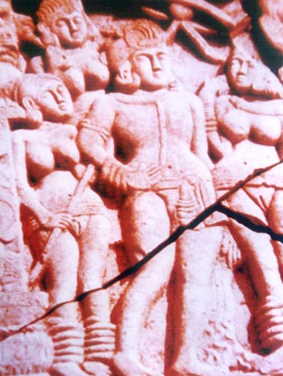
Despite reputation for sensuality, traditional Hindu society is highly
reserved.
Celibacy believed to be a requirement of holiness...and if it
can't
be achieved, it can at least be approximated.
Belief is linked to notions about the spiritual power of
semen.
Loss of semen is understood as equivalent to loss of life force. (this
belief is quite common around the world)
Semen is hard to come by (so to speak).
"40 days or 40 drops of blood to produce one drop of semen" is a
commonly
held belief.
As one gets older, men are meant to become more celebate
because they
are meant to be pursuing sprituality. Therefore women become the
bewitchers,
usurpers of men's spirit (semen).
Sambia Gender
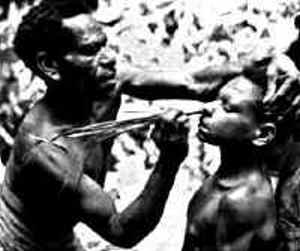
The Sambia (a typical New Guinea group) also believe that semen is
in short supply.
Young children are genderless.
However, they add the notion that children must be made into men by
the receipt of semen.
In their tribal villages the Sambia segregate the sexes as
much as possible.
Men and women each have their own paths and meeting places. The boys
have
no contact whatever with the girls. Without regular ingestion of male
seed,
the Sambia believe, boys will never grow up into strong, mature
men.
After puberty the boys enter the second phase of initiation: it is now
their turn to provide seed for the benefit of the younger ones. They do
this until, at around age 22, they marry. Marriage terminates the young
man's ritualized-homosexual life, since once his penis has penetrated a
woman's vagina it is no longer considered clean and it would be
dangerous
for any other male to touch it.
December 1, 2006
And Then, Of Course, There Were the Greeks...

(illustration from Warms' lecture notes)
This scene, from 550 BCE illustrates the erastes/eromenos relationship.
The model for homoerotic attachments in antiquity was that of
elder
erastes (lover, pursuer, and active participant) and younger eromenos
(beloved,
pursued and passive participant). Individuals did not switch roles as
the
mood struck, and at least in Athens, coeval partnerships were frowned
on.
Berdache/Two-Spirit
The Hyper-male/Hyper-female And The Warrior Society
In many societies there were men who dressed as women and took women's
roles.
The berdache, or two-spirit among many Native American groups is
typical.
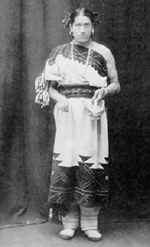
A Zuni Berdache
The berdache was a "super-woman" and consorting with a
berdache or marrying
one was understood as adding to the warrior's masculinity.
From Wikipedia, http://en.wikipedia.org/wiki/Two-Spirit:
| The older term "berdache" is a generic term used
primarily by anthropologists,
and is frequently rejected as inappropriate and offensive by Native
Americans.
This may be largely due to its pejorative etymology as it is a loan
from
French bardache via Spanish bardaxa or bardaje/bardaja via Italian
bardasso
or berdasia via Arabic bardaj meaning "kept boy; male prostitute,
catamite"
from Persian bardaj < Middle Persian vartak < Old Iranian
*varta-,
cognate to Avestan var?ta- "seized, prisoner," formed from an
Indo-European
root *wel? meaning "to strike, wound" (which is the same in English as
vulnerable). It has widely been replaced with two-spirit.
These individuals are often viewed as having two spirits
occupying one
body. Their dress is usually a mixture of traditionally male and
traditionally
female articles. They have distinct gender and social roles in their
tribes.
For instance, among the Lakota there was one ceremony during the Sun
Dance
that was performed only by a two-spirited person of that tribe. (See
winkte)
Two-spirited individuals perform specific social
functions in their
communities. In some tribes male-bodied two-spirits were active as
healers
or medicine persons, gravediggers, undertakers, handling and burying of
the deceased, conducted mourning rites, conveyers of oral traditions
and
songs, nurses during war expeditions, foretold the future, conferred
lucky
names on children or adults, wove, made pottery, made beadwork and
quillwork,
arranged marriages, made feather regalia for dances, special skills in
games of chance, led scalp-dances, and fulfilled special functions in
connection
with the setting up of the central post for the Sun Dance. In some
tribes
female-bodied two-spirits typically took on roles such as chief,
council,
trader, hunter, trapper, fisher, warfare, raider, guides, peace
missions,
vision quests, prophets, and medicine persons.
Some examples of two-spirited people in history include
the accounts
by Spanish conquistadors who spotted a two-spirited individual(s) in
almost
every village they entered in Central America.
There are descriptions of two-spirited individuals
having strong mystical
powers. In one account, raiding soldiers of a rival tribe begin to
attack
a group of foraging women when they perceive that one of the women, the
one that does not run away, is a two-spirit. They halt their attack and
retreat after the two-spirit counters them with a stick, determining
that
the two-spirit will have great power which they will not be able to
overcome.
Native people have often been perceived as "warriors,"
and with the
acknowledgement of two-spirit people that romanticized identity becomes
broken. In order to justify this new "Indian" identity many explained
it
away as a “form of social failure, women-men are seen as individuals
who
are not in a position to adapt themselves to the masculine role
prescribed
by their culture” (Lang, 28). Lang goes on to suggest that two-spirit
people
lost masculine power socially, so they took on female social roles to
climb
back up the social ladder within the tribe.
Cross dressing of two-spirit people was not always an
indicator of cross
acting (taking on other gender roles and social status within the
tribe).
Lang explains “the mere fact that a male wears women’s clothing does
not
say something about his role behavior, his gender status, or even his
choice
of partner…” (62). Often within tribes a child’s gender was decided
depending
on by either their inclination toward either masculine or feminine
activities,
or their intersex status. Puberty was about the time frame by which
clothing
choices were made to physically display their gender choice.
Two-spirit people, specifically male-bodied
(biologically male, gender
female), could go to war and have access to male activities such as
sweat
lodges. However, they also took on female roles such as cooking and
other
domestic responsibilities. Today’s societal standards look down upon
feminine
males, and this perception of that identity has trickled into Native
society.
The acculturation of these attitudes has created a sense of shame
towards
two-spirit males who live or dress as females and no longer wish to
understand
the dual lifestyle they possess.
Some tribes, notably the Comanche, Eyak and Iroquois,
did not have words
for, or recognize the existence of, two-spirits. This is true of most
Apache
bands as well, except for the Lipan, Chiricahua, Mescalero, and
southern
Dilzhe'e. Although all tribes were influenced by European
homophobia/transphobia,
certain tribes were particularly so, such as the Dilzhe'e (Tonto)
Apache,
Cocopa, Costanoan, Klamath, Maidu, Mohave, Omaha, Oto, Pima, Wind River
Shoshone, Tolowa, and Winnebago.
|
19th Century Plains Indian cultures were unusual. This
was a
culture which came to focus on the horse, a non-native breed, but one
which
had opened up so many possibilities for them. These were farmers who
gave
up farming in part because the horse made it so much easier to hunt
buffalo--
to hunt nearly anything. Mobility given by the horse made possible the
whole trading post network.
Warfare gained incredible mobility and speed.
Being a warrior escalated to becoming the hyper-warrior--- brave,
courageous,
perhaps foolhardy--
there was the daring "counting coup".
from http://www.fourwindsnp.com/dance_coup_sticks/
"The ultimate act of bravery was to get close enough to touch an enemy
with a coup stick and let him live (and also survive himself!) This
allowed
him to claim some of his opponents medicine or spiritual powers.
A warrior who was really brave might even touch an enemy with
his bare
hand. If he also killed his enemy, after touching him and finally
scalped
him, he could count three coups. Stealing a horse from an enemy would
entitle
a warrior to count coup also. He could count coup by dashing into the
enemy's
village and striking a tepee or lodge and then was said to have
"captured"
the tepee. Whatever design or symbol was painted on the enemy tepee the
warrior could paint on his own.
Should a warrior count coup on an enemy tepee, enter and touch
a live
enemy, finally kill and scalp him and on his way out of camp steal a
horse
he would have plenty to boast about!"
Warms postulates that hyper-female entities were needed for
these kinds
of hyper-male entities.
Hijras
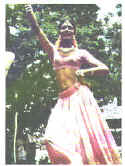
The Hijras are a third-gender group: neither male nor female.
They are devotees of the fertility goddess Bahuchara and their dancing
performances bring fertility to newly married couples and new born
babies.
Hijra are born male but undergo voluntary castration. They are thus,
eunuchs.
info from http://www.worldpress.org/Asia/845.cfm
"The Hijra code, a set of unwritten rules, compels all those who join
to wear women’s clothing and to have women’s hairdos. They are often
taken
for women, but their goal is not to fool other people. “No,” says
Farrah,
“everyone should see that we are Hijras and are proud of it.” In truth,
you can spot Hijras at a distance from the way they clap their hands as
they go through the bazaars in the afternoon, making obscene gestures
and
rude remarks in front of shops where customers hang out. Everyone knows
that the Hijras will leave only when the shop owner gives them money,
usually
10-20 rupees [US20-41 cents]. They are offensive and mocking, not so
much
because they want to be, but because tradition demands it. That is
their
job.
Hijras are considered dangerous. They can bestow not only
blessings
but also curses. The curse of childlessness is wielded as a weapon
against
anyone who makes fun of them or refuses to give them money. But usually
the Hijras bestow blessings, as only blessings bring them money, up to
1,000 rupees (officially worth about $20 but actually worth about $340
in purchasing power).The attitude of Pakistanis toward Hijras is
contradictory:
Some accept them, others hate them, many fear them, many are amazed by
them, a few like them, many make fun of them, and no one invites them
in.
They are considered unclean, and only their lovers eat with them at the
same table. “Only a Hijra can understand another Hijra!” claims Farrah.
Even for me, after living with them for months, they remain mysterious
and incomprehensible. Once, when I ventured to doubt a bold assertion,
Farrah warned me impishly, “Just be careful, all Hijras lie!”"
Read more about Hijras here: http://www.thingsasian.com/stories-photos/2022
Interestingly, there are no social institutions where women
act similarly
to the men in the above examples. It seems to be an idiosyncratic thing
for women. No one knows for sure why, but perhaps it is because men are
redundant and women are not. It's easy for cultures to absorb
alternative
roles for men because they do not have children.
The point of examining all of these variations is to see that
humanity
is so diverse in its attitudes and behaviors.
Worldview
We experience the world through our senses. But they react only
to light, sound, and other stimuli. Our brains must somehow make
sense out of these.
From a strictly sensory perspective, it is a random world upon which
our brains must impose some sort of meaning.
Imposing Meaning
Cultures impose a more-or-less systematic thread of meaning on random
reality.
We use certain underlying fundamental principles to discover the thread
of meaning that holds the random events of the world together and helps
us make sense of the chaos.
Anthropologists call these threads of meaning worldviews.
Limited Good
Some anthropologists have argued that many peasants live in a world
of limited good.
The fundamental element of their meaning is that all things exist in
finite supply.
If you believe this is the case and some are rich, where did they get
their wealth?
If you are rich, how are you going to behave?
American Worldview
So, do Americans have a worldview?
If we do, what are its basic elements?
1) Unlimited good.
2) Atheoretical pragmatism.
3) Individualism versus conformity.
4) Effort optimism (Kluckhohn)
Religion
Religion is a human universal in that every group has something that
anthropologists identify as religion. Things are complicated however,
because
not all groups have words for religion or understand what they do in
the
same way Westerners understand religion.
Defining Religion
It is tempting to define religion as simply belief in the
supernatural.
However, that doesn't work well. Is the existence of
"supernatural"
entities really supernatural if you believe in them?
One way we can define religion is by the characteristics we would be
likely to find in all religions.
Religions are Composed of Stories
We can call these sacred narratives or myths.
They offer explanation of origins, morality, fate, and so on.
They may be historically accurate or not but are held to be
"true"
(whatever that means).
They are myths in the sense that they have common characteristics such
as non-human characters, mystery, and the bending of natural law.
But, keep in mind that in this sense, Jesus or Moses or the Buddha
is every bit as mythic as Zeus or Hercules.
Non Empirical Worlds
Not all religions propose that supernatural entities such as gods and
spirits exist. But all propose that there is a reality that is
beyond
the ability of any form of science to measure. This is a reality
that is non-empirical. Non-empirical reality may be filled with
gods,
spirits, powers, ancestors...or as in the case of Buddhism, nothing at
all.
Rituals
Religions all have rituals in which the people interact with the
empirical.
Ritual is the principal observable manifestation of religion.
Symbolism
Religions include central symbols.
Emotion, meaning, values, and practice may all be bound up in simple
objects or ideas.
In ritual, symbols are properly manipulated, but great emotional impact
may also be had by improper manipulation of symbols.
Specialists
Every religion has people who specialize in its practice. These
are generally divided into two categories: Priests and Shamans.
Priests Full-Time Office holder, Training, State
Societies, Exclusive
Shamans Part-time Independent, Contact, All Societies,
Allows
Others
Altered States
All religions provide at least some of their members with what members
of the religion interpret as authentic experiences of non-empirical
reality.
This is done through the use of some means of reaching a trance
state...
an altered state of consciousness. Means of doing this include
music,
dance, meditation, pain, and drugs.
Variability in Religion
Note that one thing that is missing from our description of
religion
is a set of beliefs that everyone subscribes to. It would be nice
if, under all the ritual there was a set of principles believed by all
the worlds people. However, this is not the case.
What Religion Does: Explaining the Unknown
Religions offer explanations of events and conditions of existence
that seem otherwise inexplicable.
There is nothing that is explained by every religion, but some typical
topics are the origins of the earth, the origins of people, and what
happens
after death.
What Religion Does: Offers Meaning
Religions provide a reasonably coherent model of the way the world
is "supposed" to be. Within this model, they lend meaning to life
and action. This is particularly important in times of social or
personal
stress.
What Religion Does: Supports Social Order
Religion supports the social order.
People overwhelmingly tend to understand non-empirical reality as a
mirror image of their social reality. In "normal" times, everyone
believes
their society is they way that religion says society is supposed to be
(or at least the best available approximation).
Prayer and Magic
Prayer and Magic are two different ways of doing religion.
All religions use both prayer and magic, but how can we distinguish
between the two?
Prayer has nothing to do with the position of your hands. Most
prayer
functions as praise, petition, or is done to increase the sanctity of
the
actor. When people pray, they do so with the belief that the
non-empirical
acts according to its own agenda. The results of prayer are
ultimately
unknowable.
Magic is always done in petition. When people do magic, they
do so in
the belief that their words and actions compel the non-empirical
world.
If the practitioner does the right actions, then the result in
guaranteed.
Differences Can Be Subtle
Most Christians don't think of baptism as magical, but
it
is.
Christians believe that if the right ceremony is done by the right
person, the baptism has taken place.
God never looks down and says "gad what an ugly kid, I'm not going
to baptize that one!
Principles of Magic: Similarity
One of the key principles by which magic operates is similarity.
The notion is that objects that are in some way similar are magically
connected,
such that doing something to one results in something happening to the
other. The Voodoo Doll is a classic example of this type of magic.
Principles of Magic: Contagion

Shroud of Turin
Contagion is the notion that objects once in contact retain
magical
connection.
Sacrifice
If Prayer is asking and Magic is compelling, then what is sacrifice?...
Bribing!
In sacrifice we attempt to increase the efficacy of our prayers by
offering to give something up.
Types of Ritual
As anthropologists analyze ritual, they find many different types,
But all societies have Rites of Passage and Rites of Intensification.
Rites of Passage
Rites of passage are rituals that mark public changes of status.
Baptisms, coming of age, weddings, and funerals are all rites of
passage.
Rites of Intensification
All societies have rites of intensification as well. Rites of
intensification
serve to bring people together and give them a sense of identity that
is
useful in generating common action.
Changing Cultures
Cultures are constantly changing.
Two critical processes of culture change are diffusion and
innovation.
But, to say that culture is always changing does not mean that
all cultures
change at the same speed.
Historically, in most places, culture change seems to have been
relatively
slow. But, in the past several hundred years, it has speeded up
enormously.
Europe, 1000 AD
We think about European society as being wealthy and advanced, but
1000 years ago, things were pretty primitive. Much more going on in the
Middle East, China, Africa, and the Americas.
The story of culture change is, to a great degree, the story of
European
rise to wealth and power.
The other side of that story is the fall of the wealthy powers of a
thousand years ago and creation of a global economic system that, for
better
or worse, affects all the world's cultures.
An Advantage of Backwardness
Europe was relatively weak: composed of competing feudal mini-states.
Starting in 1095, the Crusades begin to bring Europeans together in
large scale enterprises.
The Crusades were ultimately disastrous militarily but they
accomplished
several ends that proved critical to future European success: They
created
new trade and new wealth; They created a critical alliance between
aristocrats
and merchant/bankers.
Merchants and Banks
To finance the Crusades, and enlarging their realm, European rulers
turned to merchants and bankers.
The result was a dynamic linkage between wealth and power.
This set the stage for the expansion of European power and the creation
of an global network of wealth.
Two Worlds
Starting in the 15th century, Europeans began pushing out in search
of wealth, power, and God.
There are many tales of the mercantile and colonial age, but there
are two essentially different themes: the Atlantic World and the Indian
World.
Disease and the Fate of the World
In the Americas, Europeans confronted a largely empty continent.
Disease ravaged native populations, oft times in advance of European
contact.
In Africa and the Indian Basin, Europeans and natives died in equal
numbers.
Critical result: Europeans were able to take over the
Americas with
relative ease.
In Africa and the Indian Ocean, Europeans and natives fought
to a relative
standstill. Europeans were unable to fully control most places
until
the 19th century (if they ever did at all).
Stock Companies and Slavery
The inability of Europeans to conquer in the East meant that the story
there was largely one of trade...the spice trade was most important. In
the West, the story was one of, first pillage, then sugar and
settlement.
Pillage and Plunder
Of course, the first way the Americas were exploited was with the
pillage
and plunder of precious metals. These went on to create Spanish
and
Portuguese wealth and power in Europe (and mostly ended up in China).
Sugar
Surprisingly, it was sugar that proved to be critical.
Humans have a universal taste for sugar. Thus, almost
any amount
that is produced will be consumed. But, historically Europeans
considered
it a rare spice. In the New World, Europeans discovered an ideal
location
for growing sugar.
Slavery
Producing sugar in the Caribbean and in South America was a road to
wealth and power. However, producing sugar required lots of
labor.
The principal source of this labor was slaves brought from
West Africa.
The vast majority of slaves were shipped from West Africa to the
Caribbean
and South America to labor on sugar plantations.
Capital to the Capitol
The wealth produced in the Caribbean was returned to England (and North
America).
In these places, it provided substantial funding for the enlightenment
and the industrial revolution.
However, in addition to the loss of millions through disease
and hardship,
this process had other critical effects:
1. Communities in Africa, the Americas, and Europe were brought into
a vast trading network.
2. They entered in ways that created poverty and instability for them,
but wealth and power for Europeans.
The Modern World
World historic processes have left us with a modern world of really
savage inequity.
Consider: the table below shows the world's ten most populous countries
by their population and GNP in 2000
| Country |
Population |
GNP |
| China |
1,261 |
840 |
| India |
1,016 |
460 |
| United States |
282 |
34,260 |
| Indonesia |
210 |
570 |
| Brazil |
170 |
3,570 |
| Russia |
146 |
1,660 |
| Pakistan |
138 |
470 |
| Bangladesh |
130 |
380 |
| Nigeria |
127 |
260 |
| Japan |
127 |
34,210 |
Wealthiest and Poorest
The differences are even more stark when we compare the wealthiest
nations with the poorest nations:
| Country |
2002 GNP |
2003 GNP |
| Luxembourg |
39470 |
43940 |
| Norway |
38730
|
43350 |
| Switzerland |
36170 |
39880 |
| United States |
35400 |
37610 |
| Japan |
34010 |
34510 |
| Denmark |
30260 |
33750 |
| Iceland |
27960 |
30810 |
| Sweden |
25970 |
28840 |
| United Kingdom |
25490 |
28350 |
| Hong Kong, China |
24500 |
25430 |
| Eritrea |
190 |
190 |
| Niger |
180 |
200 |
| Tajikistan |
170 |
190 |
| Malawi |
160 |
170 |
| Guinea-Bissau |
150 |
140 |
| Sierra
Leone |
140 |
150 |
| Liberia |
140 |
130 |
| Burundi |
100 |
100 |
| Ethiopia |
100 |
90 |
| Congo,
Dem. Rep. |
90 |
100 |
Increasing Differences
The differences between the rich and the poor have steadily increased
over the past 40 years:
| Ratio of Richest and Poorest
20% of the population,
1960-2000 |
| Year |
Ratio
of Income |
| 1960 |
30:1 |
| 1970 |
32:1 |
| 1980 |
45:1 |
| 1991 |
61:1 |
| 2000 |
70:1 |
Real Effects
These are not just numbers. The level of poverty has real effects
on real people. Consider the following infant mortality rates:
| Country |
Infant Mortality per 1000
live births |
| Sierra Leone |
195 |
| Afghanistan |
150 |
| Ethiopia |
128 |
| Cambodia |
116 |
| Zambia |
109 |
| Pakistan |
91 |
| India |
72 |
| Kenya |
62 |
| Brazil |
43 |
| Mexico |
28 |
| Venezuela |
21 |
| United States |
7 |
| Japan |
4 |
Critical Problems
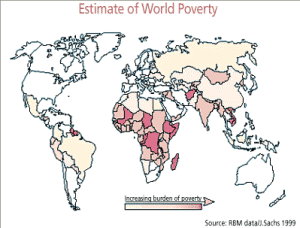
Poor nations and peoples of the world face a series of
critical problems.
These include
1. Very low levels of living
2. High levels of population growth.
3. High levels of pollution
4. Unprecedented Urbanization
5. Dominance, dependence, and vulnerability in economic and political
relations.
Low Levels of Living
About one quarter of the world's population lives on a dollar a day
or less.
Hundreds of millions of people are deprived of things that we consider
essential.
Consider:
| Lack of access to health services |
766 million |
| Lack of access to safe water |
968 million |
| Lack of access to sanitation |
2.4 billion |
| Children dying before age 5 from
preventable causes |
11 million |
| Underweight children age 5 |
163 million |
| People living with HIV |
34 million |
| Illiterate adults |
854 million |
| Children not in school |
325 million |
| Source: UNDP Human
Development Report, 2001 |
Pollution
On the one hand, the vast majority of world pollution is caused by
the wealthiest nations.
On the other hand, people in poor nations often live in profoundly
polluted environments.
For example, pollution levels for the most polluted 25% of high income
cities are lower than for the least polluted 25% of low income cities.
Population Pressure
World population has reached unprecedented levels.
1. On the one hand, population growth seems to be critical to
the generation
of wealth. All rich nations experienced high levels of population
growth;
2. On the other hand:
a) population growth has never been as high as it has in the past 40
years.
b) providing basic services to rapidly expanding populations is
extremely
difficult.
How Many People?
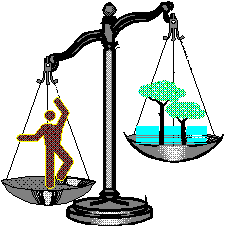
How many people can the earth support? No one knows.
Ultimately, the question is not about resources but about quality of
life and biodiversity.
Urbanization
Many of the world's biggest cities are in poor nations.
How can poor governments provide basic services to cities of more than
20,000 people?
Five biggest cities today:
Tokyo 26.8 million
Sao Paulo 16.4 million
New York 16.3
Mexico City 15.6
Bombay 15.1
Five biggest cities in 2015
Tokyo 28.7 million
Bombay 27.4
Lagos 24.4
Shanghai 23.4
Jakarta 21.2
Multi National Corporations
Top 10 MNCs
General Electric (US)
ExxonMobil Corp. (US)
Royal Dutch Shell Group (Netherlands/UK)
General Motors (US)
Ford (US)
Toyota (Japan)
Daimler-Chrysler (Germany)
TotalFina (France)
IBM (US)
BP (UK)
Consider:
Seven of the top 10 MNCs and 10 of the top 40 had worldwide sales in
excess of $100 billion in 1999.
Any three of them account for more sales than the gross national income
of all of sub-Saharan Africa.
Any four of the are larger than the economy of India
Four of the top ten are individually larger than Indonesia
The top seven together are larger than China.
Instability
The burden of instability falls disproportionately on the world's poor.
In the 20th century people predicted the emergence of
superstates and
world government. Instead, the past twenty five years have seen
the
breakup of large states in Europe and to some degree in Africa and
Asia.
Improvements in technology and manufacturing have made
advanced means
of communication, weaponry, and data manipulation that were once the
prerogative
of wealthy country governments into consumer items.
What's an anthropologist to do?
End of Course
|
